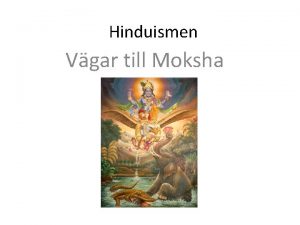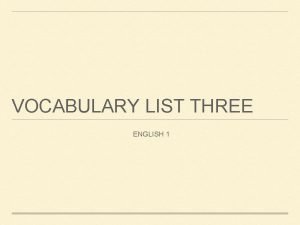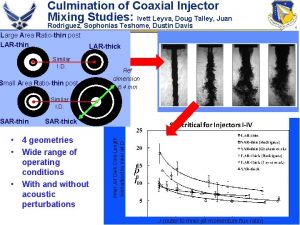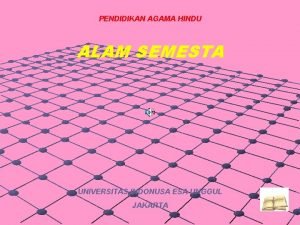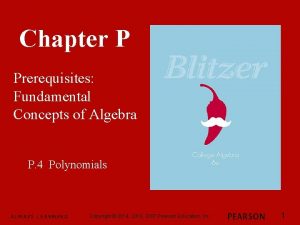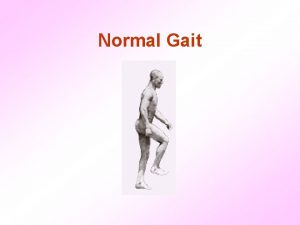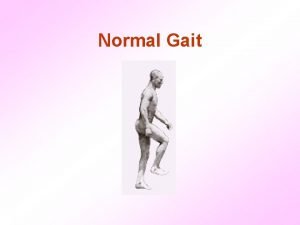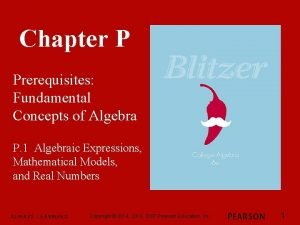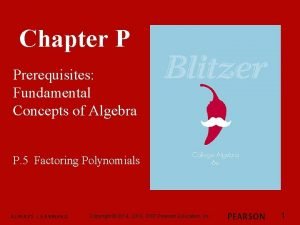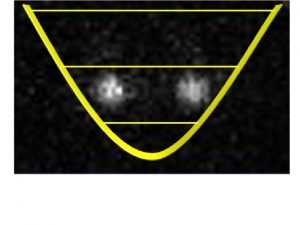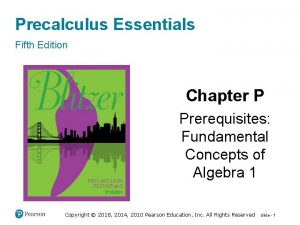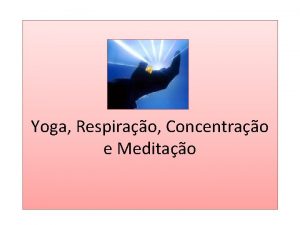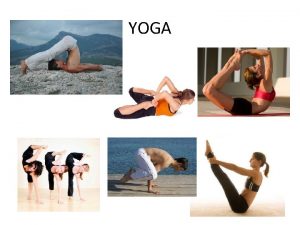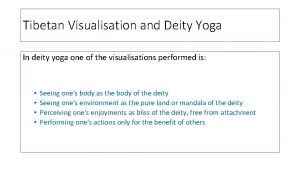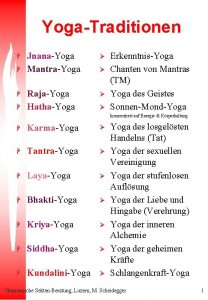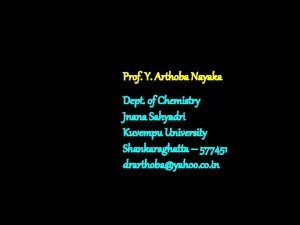Jnana Yoga Goal Prerequisites Process and Culmination Goal































- Slides: 31

Jnana Yoga Goal, Pre-requisites, Process and Culmination

Goal of Jnana Yoga • Freedom from sorrow (shoka) and delusion (moha) • Complete fulfillment • Unshakable sense of security, happiness and peace • Tranquility when facing success and failure in life

Principle • Anything finite and non-eternal cannot be completely fulfilling. • Anything that has a beginning should have an end. Anything that comes will have to go. • This implies that what is to be achieved is infinite and eternal, and it is already here. • It is only an ignorance of its presence that creates unfulfillment. • Knowledge (Jnana) is the only remedy for ignorance. • So, Knowledge is the only means to complete fulfillment.

Knowledge of What? • Me • World • My relationship with the World

Pre-requisites • Unbiased mind (vishuddhaatmaa) – Free from likes (raaga) and dislikes (dvesha) • Calm mind (vijitaatma) • Introverted mind (jitendriyah)

Preparations • Karma Yoga – to get an unbiased mind that is free from likes and dislikes • Samaadhi Yoga – to get a calm introverted mind. Also called Upaasana Yoga or Patanjali’s Ashtaanga Yoga.

Process • Hear or read about the Truth (sravana) • Think deeply about it and clear all questions and doubts about it (manana) • Think about the implications of it in everyday life and transform emotionally (nididhyaasana)

What is the Truth?

What does it mean? • Subject and object are the same. • There is only one underlying entity that is both me and the world. • Everything is me only.

Who am I? … • Let us understand subject and object characteristics and relationships. • Eye is the subject; objects of vision are objects; properties like shape, size, color, etc are of the object.

Who am I? … • The mind is the subject; eye is the object; properties like healthy, blind, myopic, color blind, etc are of the object.

Who am I? … • I am the subject; mind is the object; properties like awake, dreaming and asleep are of the object. • I am the one who knows that I slept well last night.

Who am I? … • I am the ultimate subject. • Discarding all that can be objectified, what is left is what I am. • I can never be an object. (aprameya)

Who am I? … • • All properties belong to objects only. Subject can never have properties. I have no properties. (nirguna) That which does not have properties cannot be prone to any change. (nirvikaara) • That which does not change is eternal (nitya) and omnipresent (sarvatra). • That which does not change cannot do any action (akartaa) nor can be affected by any action (abhoktaa).

Who am I? • • • I am the ultimate Subject. I have no properties. I am changeless. I am eternal. I am omnipresent. I am non-doer of any action. • I am unaffected by anything.

What is an Object? … • An object is perceived by the sense organs. It affects one or more of the five senses. (rupa) • An object has a mental image and a name associated with it. (naama) Even a new object is related to an already existing mental image. Even an abstract object which doesn’t have rupa has a naama.

What is an Object? … • Is there more to an object apart from rupa and naama? • What is common between even two most dissimilar objects – let us say a frog and a mug?

What is an Object? … • We usually ignore the obvious. • They both EXIST (asti). • They both GET KNOWN (bhaati). • How they get known depends on the senses and mind.

What is an Object? … • Looking beyond the senses and the mind, every object that we can perceive or thinkof “EXISTS” and “SHINES FORTH” • The properties of the object are merely the “WAYS” as which it shows itself as.

What is an Object? … • A pot has a “form” and a “name”. • But in reality, it is just clay. • Similarly, if the “form” and “name” of an object is ignored, the underlying substratum is the “real” object. • The underlying “real” object just “exists” and “shines forth”.

What is an Object? • When we look beyond the properties, every object is the same (ekam). • It is without properties (nirguna). • That which does not have properties cannot be prone to any change. (nirvikaara) • Changes are only to the properties of an object. Not to the underlying “real” object itself. • That which does not change is eternal (nitya) and omnipresent (sarvatra). • That which does not change cannot do any action (akartaa) nor can be affected by any action (abhoktaa).

Subject and Object … • Both the subject and object have the same qualities: – – – Without properties Changeless Eternal Omnipresent Actionless Unaffected

Subject and Object • The only difference is that one is object (prameya) and the other is subject (aprameya). • This is familiar. • The object is only a mirror image of the subject.

This is the Truth

Implications … • There is only one “real” changeless entity, which is “I”, the subject. • The world is just a mirror image of the subject. • All changes are to properties only. • I am never affected by the properties of anything and the changes to properties.

Implications … • I am infinite. • I am eternal. • It is the properties of the objects in the world that changes. • I am just a witness. • I am pure conscious (chit) existence (sat) full of bliss (aananda).

Implications … • I am ever fulfilled. • I don’t lack anything. • There is nothing that I need to achieve. • There is no place for desire, greed, jealousy, pride, anger, etc.

Implications … • I just keep watching the play of the properties that goes on in the world. • I sportively play my role without worrying too much about success or failure. • It is just a game. Winning or losing does not matter. There is no need to cheat.

Implications • Everyone and everything is “I” only. • Everything is in me and I am in everything. • Yet I am unaffected by all this. • In fact, “I” don’t play at all. It is just a play of properties.

Jnana • This is the Truth. • This Truth alone can give complete fulfillment. • This alone can give freedom from sorrow. • Knowing this Truth, there is nothing more to be known.

 Vägar till moksha
Vägar till moksha Culmination stage fashion
Culmination stage fashion Indulge adjective
Indulge adjective Ivett leyva
Ivett leyva Panca budindria
Panca budindria Samyak jnana
Samyak jnana Catur marga yoga adalah
Catur marga yoga adalah Prerequisites in performance management process
Prerequisites in performance management process Introduction for recruitment and selection
Introduction for recruitment and selection Lone star college nursing program
Lone star college nursing program Group discussion definition
Group discussion definition Gcc nursing program prerequisites
Gcc nursing program prerequisites Glendale community college nursing application deadline
Glendale community college nursing application deadline Chapter p prerequisites fundamental concepts of algebra
Chapter p prerequisites fundamental concepts of algebra Forceps prerequisites mnemonic
Forceps prerequisites mnemonic Aecp fy 2023
Aecp fy 2023 Prerequisites of gait
Prerequisites of gait Normal gait medical term
Normal gait medical term Glendale community college nursing prerequisites
Glendale community college nursing prerequisites Prerequisites of gait
Prerequisites of gait Chapter p prerequisites fundamental concepts of algebra
Chapter p prerequisites fundamental concepts of algebra Chapter p prerequisites fundamental concepts of algebra
Chapter p prerequisites fundamental concepts of algebra Communications merit badge
Communications merit badge Prerequisites for ssdt
Prerequisites for ssdt Image processing prerequisites
Image processing prerequisites Prerequisites for quantum computing
Prerequisites for quantum computing Chapter p prerequisites
Chapter p prerequisites Waterloo pharmacy prerequisites
Waterloo pharmacy prerequisites Ap spanish prerequisites
Ap spanish prerequisites Ucla
Ucla Health education topics for primary school students
Health education topics for primary school students Haccp prerequisite programs
Haccp prerequisite programs
